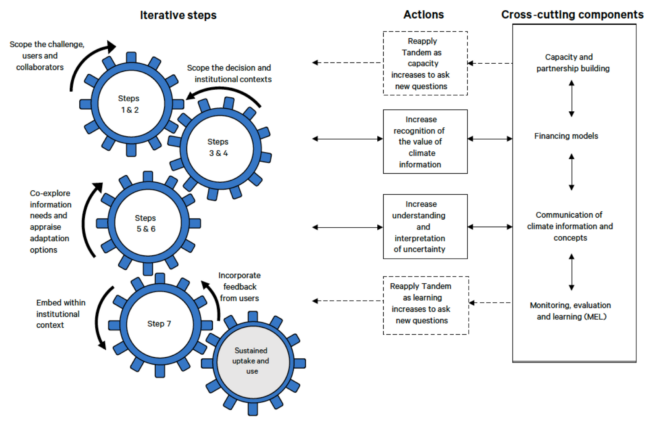The Tandem framework: a holistic approach to co-designing climate services

This framework is a key output of the SEI Climate Services Initiative, whichaims to develop new approaches for the improved design, use and interpretation of climate services, from the local to the national level. The framework has been further updated and is described in a paper: “Refocusing the climate services lens: Introducing a framework for co-designing “transdisciplinary knowledge integration processes” to build climate resilience”.
Introduction
When climate scientists work in tandem with users, climate science is more likely to be incorporated into decisions and policies.
Decisions underpinned by climate science are needed to respond to the global challenge of climate change and to meet Agenda 2030 goals. For example, farmers benefit from knowing the expected onset of rains, and policymakers benefit from understanding how the distribution of vector-borne diseases can shift with changes in temperature and rainfall. Despite the tremendous potential to integrate climate information into decision-making and planning, climate services (see Box 1) often remain poorly designed and under-utilized. To address the “usability gap” climate information must be robust, relevant, and tailored to the needs, capacities, and institutional and decision contexts of the services’ potential users (e.g., decision-makers, city planners and extension officers).
This brief* presents a framework for the development of climate services that support decision-making for adaptation (hereafter, decision-making or decisions). Though the brief largely targets climate information providers (e.g., climatologists, meteorologists) and intermediaries (e.g., adaptation and learning specialists, natural and social scientists) – the two groups currently leading climate service design processes – it should prove useful in empowering decision-makers to lead, plan and take action. This brief includes:
- a summary of key barriers to the use of climate information, specifically for adaptation planning and decision-making;
- an explanation of why collaborative and iterative processes are important for effective climate service design;
- a new framework, “Tandem”, to inform, guide, and structure interaction between the providers of climate information, intermediaries, and users; and
- an urban water-security planning example from Lusaka, Zambia, that illustrates the added value of the Tandem framework.
*Download the full text from the right-hand column.
Key messages
- Decision-makers under-utilize climate information. The situation calls for a fundamental shift: away from provider-led services for decision-makers, and to a collaborative approach working in tandem with decision-makers.
- The Tandem framework provides a holistic approach for the co-design of climate services. It engages intended users of services as full design partners collaborating with providers and intermediaries. The framework proposes iterative steps that the three parties can collectively use to inform, guide and structure their transdisciplinary interaction.
- Tandem embeds the co-design of climate services within the institutional and decision contexts in which they will operate to enhance their usability, relevance, and sustainability – all critical for climate-resilient planning underpinned by science, now and into the future.
Overview
SEI researchers have designed a framework that outlines an approach for engaging intended users of climate change-related services as co-designers and co-producers of the services.
The Tandem framework is designed to inform, guide and structure interaction between the varied participants in this process of linking climate services and climate decision-making. The aim is to enhance the usability, relevance,and sustainabilityof such services. These are essential issues for climate-resilient planning and policymaking underpinned by science, now and into the future.
Traditional supply-driven climate services usually establish a one-directional, science-to-policy relationship that has seldom led to policy action. A call is growing for a new approach, for climate services to evolve by producing and sharing information through a collaborative demand-and-decision-drivenrelationship.
Research shows that, with some caveats, co-exploration, co-production and transdisciplinary approaches create knowledge that is more relevant for users – and that such information is more likely to be used in decision-making. A key aspect of such approaches is collaboration and partnership between different stakeholders, including climate scientists, impact modellers, social scientists, adaptation and learning specialists, decision-makers and planners.
A shared co-design process can build stronger relationships and strengthen both individual and institutional capacities. Providers of climate information are likely to gain greater insight into users’ information requirements and decision-making complexities. At the same time, users are likely to enhance their understanding of climate projections and data, and their capacity to deal with the associated uncertainties or limitations.
The Tandem framework
Consider a tandem bicycle. Two people with differing skills, styles, and fitness levels need to overcome these differences to pedal in harmony to move forward to reach a given destination. To achieve this, riders need to communicate with one another, and to adapt their individual approaches, learning as they go, perhaps somewhat tentatively at first, until a rhythm is set. The alternative – for each rider to embark on a solo journey at her own pace and style – may seem easier. But independent riders on such journeys face risks. Riders who find themselves adrift from a fellow rider may lose their way, or they may choose different endpoints as events unfold along the way. Indeed, without close communication en route about complications (traffic, road closures, weather, for example), independent riders may never reach the same destination.
This is the philosophy that underpins the tandem concept. Providers driving a climate service design process may ultimately steer in a direction that suits their purposes, but this direction may not necessarily be relevant or usable for intended users – rendering it ineffective for decision-making. Working in tandem with users, while more challenging, ultimately reduces this risk. Going on the journey together promotes a shared understanding of obstacles, and fosters greater collaboration and learning along the way.
The Tandem framework outlines a holistic and iterative process that draws on lessons learned from scientific literature and ongoing SEI research. The SEI Discussion Brief* also provides insights into how the process has worked in practice, in Lusaka, Zambia. Over a two-year period, the researchers worked with a range of Lusaka stakeholders, including public policymakers, to co-create participatory processes and engagements that support climate information use in city decision-making. Further detail of this case is available in the Discussion Brief*.
The Framework steps
Step 1: Identify the adaptation challenge(s).
Step 2: Identify and engage with potential users and other collaborators.
Step 3: Gain understanding of desired objectives, and identify early actions and existing services.
Step 4: Build understanding of institutional and decision contexts.
Step 5: Co-explore data and information needs, sources, formats and modes of dissemination.
Step 6: Appraise adaptation options.
Step 7. Maintain, evaluate and upgrade the service.

*Further detail can be found in the Discussion Brief which is available for download on the right hand side.
This framework has been further updated, and is described in a paper: “Refocusing the climate services lens: Introducing a framework for co-designing “transdisciplinary knowledge integration processes” to build climate resilience”.
-
Tandem case studies:
- Improving the co-production of climate services for agriculture: a case study from Nigeria
- Ten ways to support climate change adaptation planning and decision-making
- Co-designing climate services to support adaptation to natural hazards: two case studies from Sweden
- Exploring the power of collaboration to address climate change in urban Africa
- Tandem: online guidance for the co-design of climate services
- The Tandem framework: a holistic approach to co-designing climate services
- Innovative ICTs for Communicating Climate Risk
- How to understand and interpret global climate model results
- Using climate information to support adaptation planning and policy-making: Case study in Bagamoyo District, coastal Tanzania
- Accessing and Using Climate Data and Information in Fragile, Data-Poor States
- CIP-weADAPT integration continues with new dynamic visualisation of climate data
- FRACTAL Learning – Adaptation Inspiration Theme Module 1
- PARTNERS IN SCIENCE: How the People Who Should Benefit from Research Are Increasingly Shaping How It Is Done
- Framework for needs-informed research: assessing climate processes
- Learning within & about climate science: What has transdisciplinary engagement through FRACTAL taught us?
- Learning Labs in Windhoek: creating collaborative ways to address climate change in African cities
- Improved Waste Management through Public-Private Partnerships in Lusaka
(0) Comments
There is no content